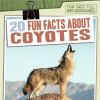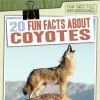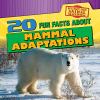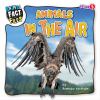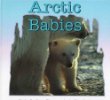-
-
2003., Adolescent, Mason Crest Call No: 599 Availability:1 of 1 At Location(s) Series Title: 100 things you should know aboutSummary Note: Contains 100 facts about mammals, the animal group that includes whales, lions, porcupines, and humans, as well as puzzles, quizzes, and related projects.
-
-
c2021., Primary, GARETH STEVENS PUBLISHING Call No: 599.37 Edition: 1st ed. Electronic ed. Click here to read this eBook Summary Note: Readers will meet nature's lumberjack and architect. They'll learn about the beaver's habitats, diet, adaptations, and about the vital role that beavers play in wetland ecosystems.
-
-
c2021., Primary, GARETH STEVENS PUBLISHING Call No: 599.37 Edition: 1st ed. Availability:1 of 1 At Location(s) Summary Note: Readers will meet nature's lumberjack and architect. They'll learn about the beaver's habitats, diet, adaptations, and about the vital role that beavers play in wetland ecosystems.
-
-
c2021., Primary, GARETH STEVENS PUBLISHING Call No: 599.77 25 Edition: 1st ed. Availability:1 of 1 At Location(s) Summary Note: Readers will meet the mysterious coyote, the canine unique to North and South America. They'll learn incredible facts about these clever creatures, such as that they are likely the first animals ever domesticated by humans.
-
-
c2021., Primary, GARETH STEVENS PUBLISHING Call No: 599.77 25 Edition: 1st ed. Electronic ed. Click here to read this eBook Summary Note: Readers will meet the mysterious coyote, the canine unique to North and South America. They'll learn incredible facts about these clever creatures, such as that they are likely the first animals ever domesticated by humans.
-
-
-- Twenty fun facts about mammal adaptationsJuvenile Call No: 599 RAJCZAK Availability:1 of 1 At Location(s) Summary Note: One major adaptation of mammals is part of what differentiates them from other animals: the growth and nourishment of babies inside the mother's body. Water-repelling fur, tough hides, camouflage, as well as the size and shape of various body parts are just a few other adaptations mammals have developed in order to better survive their environment. Readers learn many examples of how mammals have evolved to hide from predators and hunt for prey. Graphic organizers present even more information to aid readers' understanding while full-color photographs bring them close to animals they might otherwise only see in a zoo.
-
-
[1990], Juvenile, Random House Call No: 599 Par Availability:1 of 1 At Location(s) Series Title: Eyewitness juniorsSummary Note: Introduces such notable mammals as the elephant, sloth, koala, and porcupine, explains what makes them unique, and describes the important characteristics of the entire group.
-
-
-- Beavers2015, c2016., Primary, Bellwether Media Call No: 599.37 Availability:1 of 1 At Location(s) Series Title: Blastoff! readers.Summary Note: Imagine being able to swim without goggles because you have clear eyelids. For American beavers, with water-resistant hair, fins for feet, and rudder tails, they have all the equipment needed to be pros in the water. Paddle along with these graceful swimmers in this interesting read for young students.
-
-
c2015., Primary, Bellwether Media Call No: ENF 599.64 3 Availability:1 of 1 At Location(s) Series Title: Blastoff! readers. 3, North American animals.Summary Note: American bison used to number in the millions. Large herds roamed the plains of North America. Today, thousands can still be found grazing on protected lands. Find out more about the largest land animals in North America in this informative title for young readers.
-
-
By Hare, Tony1999., Facts on File Call No: 599 Availability:1 of 1 At Location(s) Summary Note: Describes the physical features and behavior of over 100 mammals, including the elephant and polar bear.
-
-
c1982, 1995., Grosset & Dunlap Call No: 599 HEL Availability:1 of 1 At Location(s) Summary Note: Text and illustrations introduce animals with fur or hair who nurse their young, breathe fresh air, and except for two species give birth to their young alive instead of laying eggs.
-
-
c2005., Crabtree Pub. Call No: LS 599 Kal Availability:1 of 1 At Location(s) Series Title: What kind of animal is it?Summary Note: Presents a children's study of mammals such as horses, lions, gorillas, whales, and others, and discusses they habitats, what they look like and how they move, how whales breathe, how they care for their young, and how they protect themselves.
-
-
c2023., Primary, Bearport Publishing Call No: 591.5 7 Availability:1 of 1 At Location(s) Summary Note: What's the deal with animals in the air? Open up this fact file to find out! Learn all about flying creatures, from birds to bats to insects. Explore where these animals live, what they eat, and more. Bright, engaging photos help readers follow along to get all the facts
-
-
1996., Juvenile, Walker Call No: 591.998 Availability:1 of 1 At Location(s) Summary Note: Photographs and text describe some of the young animals that are found in the frigid Arctic regions, including moose, foxes, walrus, porcupines, reindeer, and whales.
-
-
c2016., Primary, AV2 by Weigl Call No: 599.3 Availability:1 of 1 At Location(s)Enter URL and supply book code for this book Series Title: Animals in my backyard.Summary Note: A brief picture book introduction to armadillos, discussing their characteristics, range, habitat, food, and dangers.
-
-
By Mell, Jan1989., Crestwood House Call No: 599.5 WHALE MEL Availability:1 of 1 At Location(s) Series Title: Gone foreverSummary Note: Examines how the hunting of the Atlantic gray whale led to its extinction in the early 1700's, describes the physical characteristics, habits, and threats to the survival of the gray whale, and discusses ancient and modern whaling methods.
-
-
1986., Juvenile, National Geographic Society Call No: 599.74 446 Availability:1 of 1 At Location(s) Series Title: Books for young explorersSummary Note: Text and photographs present several kinds of bears, including polar, grizzly, and black, engaged in a variety of activities.
-
-
1986., National Geographic Society Call No: 599.74 BUX Availability:1 of 1 At Location(s) Series Title: Books for young explorersSummary Note: Text and photographs present several kinds of bears, including polar, grizzly, and black, engaged in a variety of activities.
-
-
c1994., Juvenile, HarperCollins Call No: 599.5 1 Availability:1 of 1 At Location(s) Series Title: Let's-read-and-find-out science.Summary Note: Describes the behavior of the humpback whale, with an emphasis on the fact that it is a mammal and shares the characteristics of other mammals.
-
-
By Carr, Aaronc2015., Primary, AV2 by Weigl Call No: ENF 599.7662 Availability:1 of 1 At Location(s) Series Title: Animals in my backyard.Summary Note: Badgers have large front claws that are up to 2 inches long. They use these claws for digging through the ground. Badgers can also release a strong scent. These interesting facts and more can be found in Badgers, an Animals in My Backyard book.





